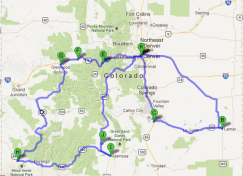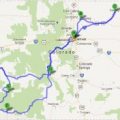
Over the past year, CCMU has made a concerted effort to travel to the far reaches of Colorado to meet with health care leaders and community members to get a firsthand account of local health care system innovations. Last September, I embarked on CCMU’s first annual statewide tour, traveling over 1,100 miles and visiting five communities that are on the cutting edge of local health care reform.
Our first tour was so enlightening I simply couldn’t wait a full year to hit the road again. So in March and April, I endured countless long drives and battled crazy snow storms to complete an even more ambitious tour of the state. CCMU’s second statewide tour covered nearly 2,000 miles and included visits to eight communities.
I returned home with a renewed reverence for the great health care minds across our fine state. I saw a wealth of great work, from groundbreaking behavioral and dental health integrations projects to coalitions of health care agencies collaborating on care plans and pooling resources. Each community I visited is designing and implementing solutions that address the most pressing local health care challenges while building on local assets and strengths.
I’ve written at length about some of the health care challenges rural communities face, including difficulties recruiting and retaining health care providers. In many areas of our state, the limited number of doctors, nurses, and other health care providers makes accessing care difficult. In fact, in the San Luis Valley, each of the six counties has designated health care professional shortage areas. Local health care leaders there have taken the issue head-on, led by the San Luis Valley Area Health Education Center (San Luis Valley AHEC), and have long been developing and implementing creative programs aimed at attracting health care providers and growing local talent to address this access gap.
Last year, the San Luis Valley AHEC published a marketing toolkit to increase local capacity to recruit primary care providers. It included best practices and resources for creating a welcoming community for medical students on clinical rotations and for potential provider recruits. The end goal is to establish a community movement to convince more doctors and nurses to settle in Rio Grande and Conejos—the two counties with the greatest need for primary care providers in the San Luis Valley.
And for the past 25 years, the San Luis Valley AHEC has been running Grow Your Own, its training program aimed at encouraging local high school students to go into medical professions. It’s been a resounding success; nearly 50% of the 250 students who’ve participated in the rigorous coursework have gone on to careers in the medical profession. Even more impressive, at least 15 of these students are currently working in full-time medical jobs in the San Luis Valley. This might not seem like a large number, but 15 health care workers in a rural area with only 40,000 residents can make a major impact.
As we continue to tackle health care issues around the state, we can learn much from the creative solutions pioneered by the San Luis Valley AHEC and other great leaders in communities around the state. While in Alamosa, some words of wisdom were shared with me: “If it takes a village to raise a child, it takes a community to recruit and retain a health provider.” At CCMU, we have always believed that community-driven solutions are the cornerstone of successful health care systems, so this quote rings particularly true to us. It will take a community—many communities—committed to working together to create local solutions to complex problems, to drive real and lasting change for a healthier Colorado.




